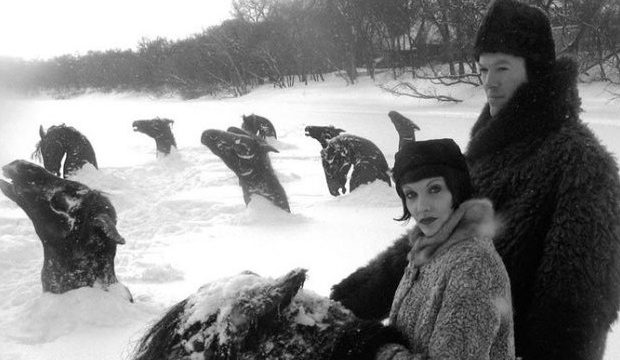Guy Maddin can’t escape his hometown either by rail or in restless dreams. Except it’s not Guy Maddin, it’s actor Darcy Fehr portraying Maddin under narration provided by the actual Maddin. And this hometown, Winnipeg, is just as often a space created whole cloth on dreamy sound stages as it is a real city captured clearly.
So goes the twisting of fact and myth in My Winnipeg, one of the great movies of 2007 and almost certainly the greatest travelogue ever filmed. Maddin’s barely tethered surrealism unmoors local legends and landmark histories from their usual dowdy obligations to the strict truth and lets them live as local histories are meant to: as celebrations of spirits only partially contained in their most arduously researched versions. That’s “spirits” as in the disposition of the local population and “spirits” as in the figures from the past reconjured with each anecdote (no other definitions – like all Canadian provinces Manitoba is beer first).
Maddin’s episodic recollections evoke proud but weary relationships with hometowns everywhere. He adds to the dubious history lessons vignettes where actors play his own family to recreate childhood memories. This extra level of specificity would seem on paper to work against the universality of the rest of the movie but in fact strengthens the identification factor. A relationship with the past of an area is inseparable from the relationships with the people there. Maddin’s personal hang-ups and tragedies may not map to our own any more than his lament for a bygone hockey team means anything to us on the surface. But he’s tapped into the sense of a thing having happened just yesterday and the loss that happens when yesterday inevitably gets buried under layers of new todays.
Did dozens of racehorses actually freeze in the Red River, heads protruding like terrifying Godfather-themed park benches? I don’t know, but the attitude the retelling conveys is familiar. For one thing, there’s a satisfaction in people who live in cold places – the closer to Arctic geographies, the stronger the pride – that comes from regularly surviving conditions that can create such horrors. Complaints about shoveling driveways are always made loud enough to shame those who avoid the work by moving to more temperate climes.
Are Maddin’s descriptions of the city swimming pool, a local restaurant, and a department store accurate? Can’t say I can verify it, but I can confirm familiarity with an old building will go deeper than can be mapped by a blueprint. The significance of past events – like a faked Nazi invasion during World War II to promote the sale of war bonds – goes beyond its original intention and becomes a fable about the ingenuity of its people. A hometown, like a family, becomes so thick with meaning and comfort despite or maybe because of everythig you’ve endured there, that one can only dream of escaping it.
The style of Guy Maddin already makes his movies look like new discoveries from the silent era, appropriate for a film that digs out gems and indiscriminately presents them without revealing if they were natural or planted there. This singular, entertaining film glorifying Winnipeg in its damnation of same was commissioned by the city itself, another feather in the cap of a city only rivaled in glory by mine or yours.

